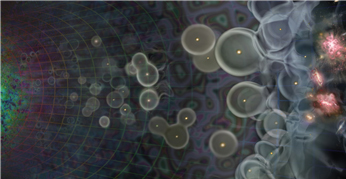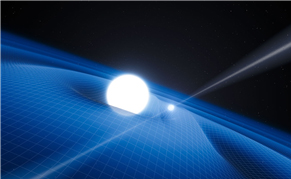SKA Science Drivers
The SKA will be a radio observatory of unparalleled sensitivity across a wide range of angular scales and radio wavelengths. Its scientific impact will spread from studies of star formation within our own Milky Way, to probing distant galaxies in the furthest reaches of the Universe. It will unveil the hidden structures of cosmic magnetic fields stretching over vast distances, and examine the organic chemistry of Earth-like terrestrial planets. It will perhaps even detect signs of extra-terrestrial life as the SKA will be sensitive enough to detect signals, comparable to terrestrial television transmitters, from planets in nearby solar systems.
From contributions to the last SKA science conference, a two volume book was recently produced describing this broad science case[1]. It contains 135 chapters written by 1,213 contributors from 31 countries. Of those chapters 62% were first-authored by scientists from European institutions. The Observatory itself is being built in South Africa and Australia, but the SKA clearly lies at the heart of the European science agenda. The headquarters for the Observatory is located in Europe in the UK, and European scientific interest spans the complete range of research areas proposed for the SKA. In particular, key European participation is currently foreseen in both of the most transformational science topics driving the SKA design. These are summarized here.
Our understanding of cosmology has grown more complete in recent years, but one of the remaining knowledge frontiers in this area is the cosmological dawn – the era when the first stars and galaxies formed. Phase 1 of the SKA will provide the first direct imaging of this Epoch of Re-ionization. This epoch happened around 380,000 years after the Big Bang when proto-galaxies and quasars began to form in a sea of neutral hydrogen. These objects are intrinsically faint and their emission suffers significant absorption by the surrounding medium, which has made it extremely difficult to detect them to date. However, an alternative way to measure growth in the early Universe is instead to observe the effect these objects have on their surroundings. These energetic objects ionize pockets of the neutral gas around them, creating voids. Astronomers have labeled this as the epoch of re-ionization and it can be observed by mapping the distribution of neutral hydrogen. The SKA will be able to image the patterns in the neutral gas during the Epoch of Re-ionization, providing the first pictures of Universe in this formative era (see Figure 2).
In terms of fundamental physics, the SKA will also allow us to perform strong field tests of gravity itself. Using pulsars, the collapsed spinning cores of dead stars, we will be able to measure ripples in the fabric of space-time caused by gravitational waves. A pulsar is a highly magnetised, rotating neutron star with a mass 1.4 times larger than the Sun, but only a few kilometres in diameter. As a pulsar spins it acts like a cosmic lighthouse, emitting a beam of radiation from its pole that periodically sweeps past the observer’s line of sight. These pulses are extremely regular and hence pulsars act as natural clocks, as precise as the best atomic clocks on Earth. This precise timing can be used to detect ripples caused by gravitational waves as well as to test general relativity in extreme gravitational conditions such as those produced in the vicinity of black holes. The SKA will be able to investigate the strong-field realm of gravitational physics by finding and timing pulsars. About 50 years after the discovery of pulsars marked the beginning of a new era in fundamental physics, pulsars observed with the SKA have the potential to transform our understanding of gravitational physics.
In addition to these flagship experiments, the SKA will enable a wide range of science. Neutral hydrogen emission surveys out to a redshift of 0.5 will allow the study of the evolution of gas in galaxies across five billion years of cosmic time, as well as placing further important constraints on the dark energy equation of state and its evolution with redshift. New classes of transient and variable sources will be detected and identified, including the recently-discovered “fast radio bursts”, at a ground-breaking rate of several detections per day. Imaging of planet-forming disks around young stars will also result in key breakthroughs related to the physics of planet formation, and in turn the origin of life itself.
1. Advancing Astrophysics with the Square Kilometre Array, https://www.skatelescope.org/books/

The earliest phases in the Universe, from left to right: the Cosmic Microwave Background (green), the time when hydrogen in the Universe became neutral and the Universe entered the “Dark Ages”. During the Cosmic Dawn, the first stars (yellow dots with bubbles) started to emit radiation heating the intergalactic medium. During re-ionisation, stars ionised hydrogen again (big, overlapping bubbles) and the Universe became transparent to radiation. It is after and during this period that we see the first galaxies (right) with present-day telescopes (e.g. HST).

Artist's conception of a pulsar orbiting a much larger white dwarf star. The extreme gravitational field of the pulsar warps space time, and its lighthouse-like radio beam allows us to precisely map its motion such that we can test the predictions of gravitational theories in a way that would be otherwise impossible.
